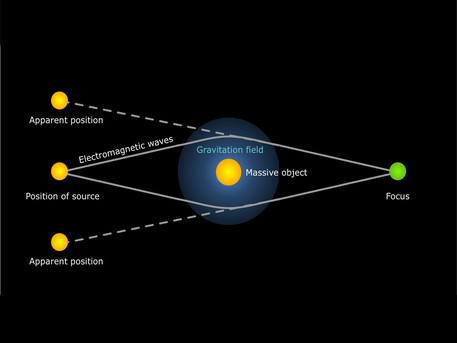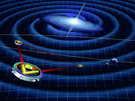Bending the light
What are gravitational lenses?
 © GFDL
|
Gravitational lenses are massive bodies which bend space. That is why electromagnetic waves such as light do not pass such a mass in a straight line but are bent in a similar way to an optical lens. Stars lying behind the gravitational lens no longer appear to be in their real position for an observer but seem to have slightly shifted.
Experimental confirmation of the general theory of relativity
In this way, Eddington achieved the first experimental confirmation of the general theory of relativity: a massive body like our Sun, for example, bends space. That is why light rays do not pass such a mass in a straight line but are bent in a similar way to an optical lens.
Gravitational lenses are therefore massive bodies - stars, galaxies or whole clusters of galaxies, for example - which bend the light from objects lying behind them. Depending on its form and the distribution of its mass, such a gravitational lens can produce changes in brightness, shifts in apparent position, distorted images or multiple images of the object under observation. Conversely, the analysis of such images allows us to draw conclusions about the form and mass of the gravitational lens and permits us to investigate the distribution of mass throughout the universe.
German Aerospace Center
Bending the light
What are gravitational lenses?
 © GFDL
|
Gravitational lenses are massive bodies which bend space. That is why electromagnetic waves such as light do not pass such a mass in a straight line but are bent in a similar way to an optical lens. Stars lying behind the gravitational lens no longer appear to be in their real position for an observer but seem to have slightly shifted.
Experimental confirmation of the general theory of relativity
In this way, Eddington achieved the first experimental confirmation of the general theory of relativity: a massive body like our Sun, for example, bends space. That is why light rays do not pass such a mass in a straight line but are bent in a similar way to an optical lens.
Gravitational lenses are therefore massive bodies - stars, galaxies or whole clusters of galaxies, for example - which bend the light from objects lying behind them. Depending on its form and the distribution of its mass, such a gravitational lens can produce changes in brightness, shifts in apparent position, distorted images or multiple images of the object under observation. Conversely, the analysis of such images allows us to draw conclusions about the form and mass of the gravitational lens and permits us to investigate the distribution of mass throughout the universe.
German Aerospace Center






